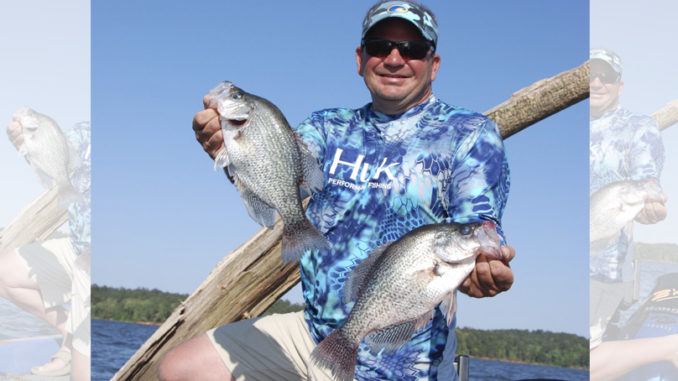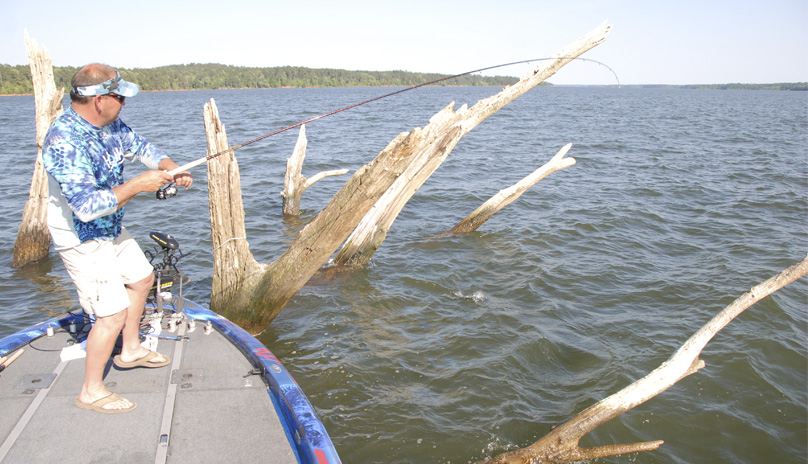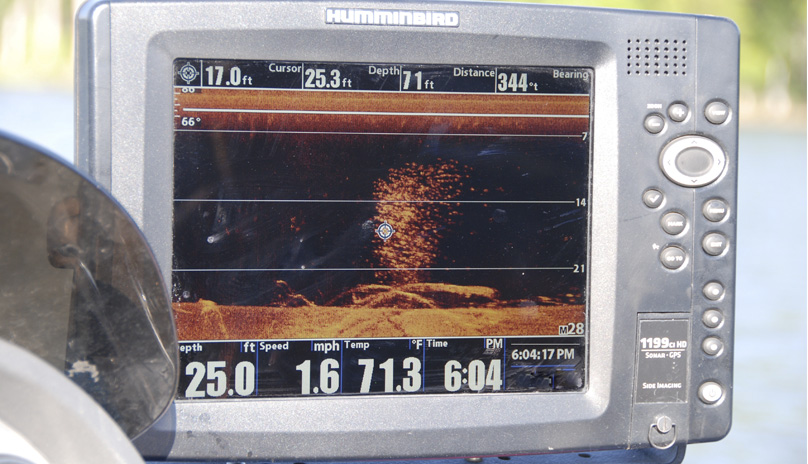
Vertical jigging around standing timber is the ticket to great summer crappie action on South Carolina’s Lake Russell.
With summer in full swing across the Upstate, many anglers have thrown in the towel when it comes to fishing. Hot temperatures, hot water and recreational boat traffic just don’t make it worth the effort to get on the water, at least during the day.
The exception is Lake Russell, the middle impoundment of the Savannah River chain. It was loosely designated as a sportsman’s lake, with 95-percent of its shoreline undeveloped and acres of standing timber. The lack of lakeside development severely reduces recreational use, and many boaters stay way, scared of losing the lower unit off an outboard motor to the timber.
But for pro crappie fisherman and guide Rod Wall of Ninety Six, those characteristics — along with some gin-clear water — are what makes him head to Lake Russell during the summer.
“This is my favorite time to crappie fish, I’ll take clear water and summertime conditions over the spring spawn or pre-spawn any day,” he said.
The method behind Wall’s madness is the proclivity of Lake Russell crappie to huddle, en masse, around groves of standing timber.
Lake Russell has plenty of standing timber for crappie to hide
“Most people who visit Lake Russell are familiar with the standing timber, because you can see it all over the lake,” Wall said. “The lake also supports about three times that much wood under the surface that you can’t see.”
Many anglers equate crappie fishing on Lake Russell to finding a needle in a haystack. In reality, it is more like finding a 200-count package of needles in a haystack. Wall further breaks the pattern down by looking for smaller stands of submerged timber, maybe a quarter-acre or less, located close to a deep-water travel route. Typically, that means he’s searching the mouths of tributaries that dump into the Rocky and Savannah Rivers.

“I like isolated patches of timber that are a quarter-acre or less,” he said. “With there being hundreds and hundreds of acres of submerged timber on Lake Russell, the first thing I look for are irregularities in that isolated stand of timber.”
During the summer, anglers and fish concentrate on finding shade. Wall said that when fishing water that may bottom out at 40 to 50 feet or deeper, fish will hold around standing timber at depths of 16 to 18 feet. At that depth, the sun is not as big a factor to fish positioning on water currents.
Lake Russell’s current sometimes runs upstream
“Lake Russell is unique because of the situation of pumping water back. Sometimes it will be going upstream in the river, and sometimes it will be going downstream, and that positions the fish more so than the shading does,” he said. “Current takes precedence over shade.”
Another factor that makes Lake Russell a tough nut to crack is that 75 percent of the time, Wall will be fishing sub-surface, standing timber that offers no visual reference. To the untrained eye, he’s just out in the middle of the lake with a fishing pole in his hand.
“Electronics are critical, especially with side-imaging,” Wall said. “With side-imaging, I can scan the perimeters of an isolated patch of timber and look for irregularities like a layover log or bushy tree. That will typically hold greater concentrations of fish. In fact, I’m looking for those white spots on the graph. What that is is a tightly packed school of crappie. I call them big ol’ snow flakes.”

Even putting his boat right over the top of a school rarely has any effect on fish. Walls surmises the fish are packed tight for security from predators, namely large striped bass, gar, catfish or anything else that eats crappie. To get those fish to bite, he drops a jig right on top of their heads, even targeting bigger “spots” in the snow-flake image, indicating the larger fish.
Russell is an underfished lake among crappie anglers
“The advantage to one-pole jigging on Russell is you’ve got open expanses of water. One pole, one bait gives you better pinpoint accuracy.” he said. “When you fish a jig vertically in deep water — I’m talking 16 to 18 feet deep — you need to go to a heavier jig head like a 1/8- or a ¼-ounce jighead. I pair that with a chenille rubber jig skirt no more than 2 inches long. My favorite colors would be chartreuse, whites, pearls, sky blues, pinks and translucent baits for sunny days.”
Wall scratches his head when asked why he typically has Lake Russell all to himself during the summer. He agrees it can be an intimidating lake, but learning its secrets, and applying some know-how has ample rewards.
“Lake Russell is a greatly ‘underfished’ crappie fishery, because most crappie anglers don’t understand how to fish clear waters,” he said. “Any time you have 3 feet of visibility or more, crappie will always be structure related in the summertime. I might spend an hour-and-a-half on the electronics, but once I find the fish in the next hour, I’ll have a limit of fish in the live well.”
DESTINATION INFORMATION
HOW TO GET THERE — Lake Russell lies on the Georgia-South Carolina line, southwest of Abbeville in Anderson and Abbeville counties. SC 81 and SC 72 provide the best access. Top public ramps are Milwood, southwest of Calhoun Falls off SC 81; Calhoun Falls State off SC 81; Beer Garden Creek, south of Calhoun Falls of SC 81; Blue Hole, west of Calhoun Falls of SC 81; Felkel, southwest of Lowndesville off CR 74; Wilson Creek, north of Lowndesville off CR 72; Allen Creek, west of Lowndesville, off CR 70.
WHEN TO GO — The time to jig for crappie in deep water starts when fish recover from spawning in May, and it will last through the summer until September, when fish begin leaving deep water as it cools.
BEST TECHNIQUES — Single-poll jigging for black crappie is a deadly technique when fish are holding deep next to standing timber, which can be submerged or visible from the surface. Look for isolated patches of standing timber around the mouths of tributaries that feed the Rocky and Savannah rivers. Crappie will orient to the downcurrent side of the timber when pump or pump-back operations are taking place. Using a good depth finder, locate fish relating to the timber and present a 3/16- or 1/4-ounce jighead with a rubber skirt in white, blue, chartreuse or pearl, vertically down into the timber. Look for fish suspended in 14 to 16 feet of water over 20 to 40 feet of water.
Guides, accomodations
FISHING INFO/GUIDES — Rod Wall, Slab Masters Guide Service, 864-993-8868; Wendell Wilson, Wilson’s Guide Service, 706-283-3336; www.wilsonsguideservice.com; Sportsman’s One Stop, Iva, 864-348-2840. See also Guides and Charters in Classifieds.
ACCOMMODATIONS — Econo Lodge, Elberton, Ga., 888-690-5281; Days Inn, Elberton, Ga., 800-230-4134; Calhoun Falls State Park camping, 864-447-8267; www.southcarolinaparks.com/calhounfalls/camping.aspx.
MAPS — Delorme South Carolina Atlas & Gazetteer, 800-561-5105, www.delorme.com; S.C. Department of Natural Resources, www.dnr.sc.gov.


Be the first to comment